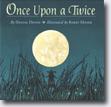 
|
A cautionary tale involving a mischievous mouse and written in the same vein as Lewis Carroll’s Jabberwocky, Once Upon a Twice is an outstanding poem illustrated with awe-inspiring paintings on full-page spreads. is an outstanding poem illustrated with awe-inspiring paintings on full-page spreads.
This is the story of a field mouse that ignores the warnings of his elders and ventures out into the open on a moonlit night. Attacked by a quiet snake, he narrowly escapes to recall the tale and warn younger generations.
Out in the open, in the clear, /
Where any wisenmouse would fear, /
Jam licks his paw, he grooms an ear,/
And never hears approaching hisss.
Doyen’s rhyming four-line stanzas, inventive words and predictable cadence beg for the poem to be read aloud. Although the vocabulary is relatively difficult and students must interpret many words by context, the lyrical text invites the readers to pay attention as the danger is foreshadowed.
Capturing the essence of a moonlit night, Moser’s paintings expand the text to aid the reader’s understanding of the text. Shining eyes, reflecting pools of water, dark shadows, a full moon and cowering mice depict the emotion of the characters and ambiance of the setting.
I paired this story with a colleague’s masterful recitation of Jabberwocky for a fourth-grade class; although sometimes befuddled by the vocabulary, the students sensed the similarities in the warnings, the rhythm of the poems, and the marvelous story of a mouse gone astray.
Essentially a poem in picture book format, this book is best appreciated by an older elementary audience who listen with thoughtful, attentive minds and an understanding that thinking is a critical component to comprehension, especially with ambiguous vocabulary and unfamiliar rhymes. A story that grows better each time it is read, Once Upon a Twice is best read aloud with attention paid to both the words and the breathtaking paintings of ordinary mice on an extraordinary evening. is best read aloud with attention paid to both the words and the breathtaking paintings of ordinary mice on an extraordinary evening.
|







|